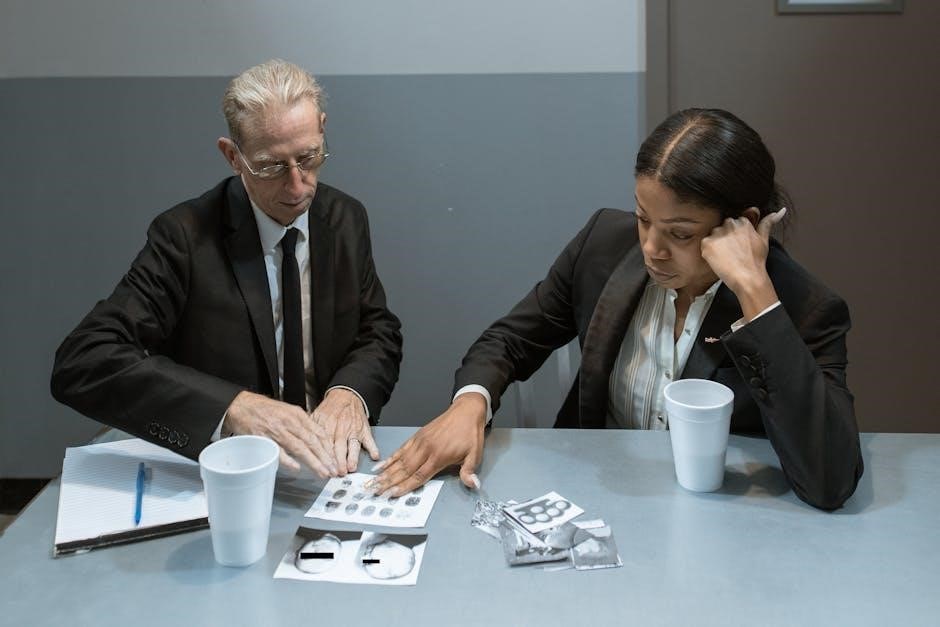St. Jude pacemaker interrogation involves using a programmer to assess device function, battery life, and heart rhythm data, ensuring optimal pacing and early detection of potential issues.

Overview of Pacemaker Interrogation
Pacemaker interrogation is a diagnostic process using a programmer to assess device performance, battery life, and heart rhythm data. It ensures proper pacing, detects issues early, and guides adjustments. The process involves retrieving stored data, analyzing trends, and verifying settings. Advanced systems like Abbott’s Aveir DR dual-chamber leadless pacemaker offer enhanced monitoring. Tools such as the Merlin Pacing System Analyzer aid in evaluating electrical performance. Regular interrogation is vital for maintaining optimal device function and patient health, ensuring timely interventions and personalized care. This step is critical for both initial setup and ongoing management of pacemaker therapy.
Importance of Regular Interrogation
Regular pacemaker interrogation is crucial for ensuring optimal device performance and patient safety. It allows healthcare providers to monitor battery life, verify pacing settings, and detect potential malfunctions early. Abbott’s Aveir DR system, for instance, enables remote monitoring, reducing the need for in-person visits. Regular checks prevent sudden device failures and ensure proper heart rhythm management. Additionally, they help in identifying and addressing issues like communication errors or lead integrity problems. Consistent monitoring through tools like the Merlin PSA ensures personalized care, improves outcomes, and extends device longevity, making regular interrogation a cornerstone of effective pacemaker management.

Preparation for Pacemaker Interrogation
Gather the programmer, ensure software updates, and prepare the patient by removing external devices. Review patient history and previous data for a smooth interrogation process.
Equipment and Software Requirements
To perform St. Jude pacemaker interrogation, you need a compatible programmer, such as the Merlin 2.0 or newer. Ensure the software is updated to the latest version for accurate data retrieval. Additionally, a wand or telemetry module is required for communication with the pacemaker. Access to the manufacturer’s manuals and troubleshooting guides is essential. A reliable power source and ECG equipment for patient monitoring are also necessary. Ensure the interrogation environment is free from electromagnetic interference for accurate results. Proper preparation of these tools ensures efficient and safe device analysis.
Patient Preparation and Safety Measures
Before St. Jude pacemaker interrogation, ensure the patient is informed and comfortable. Remove any ferromagnetic items and ensure the patient remains still during the procedure. Verify the presence of emergency equipment nearby. Use ECG monitoring to track heart activity. Ensure the programmer is set to the correct mode and settings. Document any pre-existing conditions or allergies. Avoid placing the telemetry wand directly over the pacemaker to prevent interference. Maintain a sterile environment if accessing the device. Ensure the patient understands the procedure and can report any unusual symptoms. Proper preparation ensures safety and accurate device assessment.

Step-by-Step Interrogation Process
The process involves connecting the pacemaker to the programmer, retrieving data, analyzing heart rhythms, and adjusting settings to optimize device performance and patient outcomes.
Connecting the Pacemaker to the Programmer
To connect the pacemaker to the programmer, place the programming wand over the device, ensuring proper alignment and skin contact. Turn on the programmer and select the appropriate software. The device should be automatically detected, allowing data retrieval. Confirm the model and settings displayed match the patient’s pacemaker. Ensure the environment is free from interference. Use the wand’s markings to guide placement. If issues arise, reposition the wand or check for software updates. Always follow safety protocols and manufacturer guidelines when initializing the connection to avoid any disruption in pacing therapy. Proper connection is critical for accurate data analysis and effective device management.
Retrieving and Analyzing Device Data
Once connected, the programmer retrieves data from the pacemaker, including battery life, pacing thresholds, and stored electrograms (EGMs). Analyze this data to assess device function and heart rhythm. Use software tools to review trends in atrial and ventricular activity, ensuring proper pacing and sensing. Check for any alarms or alerts indicating issues like lead impedance changes or arrhythmia episodes. Compare current settings with previous data to track progression and make informed adjustments. Accurate analysis ensures optimal device performance and guides clinical decision-making for patient care. Regular data review is essential for maintaining pacing efficacy and patient safety. Always follow manufacturer guidelines for interpretation.
Adjusting Settings and Programming the Device
After analyzing the data, adjustments to the pacemaker settings are made using the programmer. This includes modifying pacing modes, sensitivity, and rate limits based on patient needs. The programmer allows real-time adjustments to ensure optimal heart rhythm management. Advanced features like rate responsive pacing can be enabled or fine-tuned. Settings are carefully tailored to the patient’s condition, ensuring proper device function. Once adjustments are made, the programmer verifies the changes to confirm they are correctly implemented. Always refer to the manufacturer’s guidelines for specific programming instructions and document all changes for future reference. Proper programming ensures effective therapy and patient safety.
Troubleshooting Common Issues
During pacemaker interrogation, common issues like communication errors or inappropriate pacing may arise. These are often resolved by checking the programmer’s connection to the device. If issues persist, reprogramming settings or adjusting sensitivity can address the problem. Battery-related alerts or abnormal heart rhythms may require immediate attention. The programmer provides detailed diagnostics to identify malfunctions. In some cases, resetting the device or updating software may be necessary. Always refer to the manufacturer’s troubleshooting guide for specific solutions. Documenting these issues ensures proper follow-up and helps prevent future complications. Effective troubleshooting is key to maintaining optimal device performance and patient safety.

Advanced Features of St. Jude Pacemakers
St. Jude pacemakers offer advanced features like automatic mode switching, rate responsive pacing, and remote monitoring capabilities, enhancing personalized care and improving patient outcomes significantly.
Automatic Mode Switching
Automatic mode switching in St. Jude pacemakers allows seamless transitions between pacing modes based on patient activity and heart rhythm changes, optimizing device performance and patient comfort. This feature ensures the pacemaker adapts to various physiological conditions, switching between atrial, ventricular, or dual-chamber pacing as needed. It minimizes inappropriate pacing and enhances the device’s ability to maintain a natural heart rhythm. During interrogation, clinicians can verify the mode switching algorithm’s functionality, review event logs, and adjust settings to improve patient-specific outcomes. This capability is crucial for patients with dynamic heart conditions, ensuring tailored pacing support throughout daily activities.

Rate Responsive Pacing
Rate responsive pacing in St. Jude pacemakers adjusts heart rate based on physical activity or physiological needs, enhancing exercise tolerance and reducing symptoms. Sensors, such as accelerometers or minute ventilation, detect activity levels and adjust pacing accordingly. This feature ensures the heart rate adapts naturally during exertion or rest. During interrogation, clinicians can evaluate sensor performance, verify rate responses, and customize thresholds to optimize patient outcomes. Proper programming of rate responsive settings is essential for maintaining a balanced and effective pacing strategy tailored to individual patient lifestyles and conditions.
Remote Monitoring Capabilities
St. Jude pacemakers offer advanced remote monitoring capabilities, enabling continuous oversight of patient heart rhythms and device performance. Through a remote home monitor, the pacemaker transmits data automatically, allowing early detection of arrhythmias or device malfunctions. Clinicians can access real-time insights, reducing the need for in-person visits. Remote monitoring enhances patient safety by providing timely alerts for critical events, such as abnormal heart activity or battery depletion. This feature supports proactive care, improving patient outcomes and reducing complications. Regular remote checks ensure seamless monitoring and early intervention, making it a vital tool for modern pacemaker management.

Post-Interrogation Procedures
Following interrogation, ensure all device settings are documented and communicated to the patient. Schedule follow-up appointments and provide clear instructions for monitoring and reporting any changes.
Documenting Findings and Changes
Accurate documentation of pacemaker interrogation findings is crucial for patient care. Record all observed data, including battery status, pacing thresholds, and arrhythmia episodes. Note any programming adjustments made to ensure optimal device function. Use standardized templates or software tools provided by St. Jude to maintain consistency. Include details about patient symptoms, device performance, and any troubleshooting steps taken. Ensure all changes are validated and approved by the healthcare team. Maintain a comprehensive record for future reference and legal compliance. This documentation serves as a critical resource for ongoing patient management and ensures continuity of care.

Patient Education and Follow-Up
Patient education is vital for successful pacemaker management. Explain the device’s purpose, operation, and lifestyle adjustments needed. Emphasize the importance of follow-up appointments for regular device checks. Teach patients to monitor for symptoms like dizziness or palpitations and to report them immediately. Provide written instructions on living with a pacemaker, including MRI safety and emergency procedures. Schedule routine follow-ups to ensure optimal device performance and address any concerns. Remote monitoring can be used to track the pacemaker between in-person visits, enhancing patient safety and care continuity. Educating patients empowers them to actively participate in their cardiac health management.

Troubleshooting and Error Resolution
Identify and address common issues like communication errors or device malfunctions during interrogation. Use diagnostic tools to resolve problems and ensure proper device function and patient safety.
Identifying and Addressing Device Malfunctions
Device malfunctions during St. Jude pacemaker interrogation can often be identified through error codes or abnormal readings. Common issues include battery depletion, lead malfunction, or improper pacing. Use the programmer to analyze real-time data and historical trends to pinpoint the problem. Addressing malfunctions may involve reprogramming settings, replacing the lead, or scheduling a device replacement. Ensure all corrections are documented and communicated to the patient. Regular monitoring and follow-up appointments are crucial to prevent recurrence and maintain optimal device performance, ensuring patient safety and effective cardiac rhythm management.

Resolving Communication Issues
Communication issues during St. Jude pacemaker interrogation can arise due to faulty connections, outdated software, or environmental interference. Begin by checking the programmer’s hardware and ensuring all cables are securely connected. Restart the system and verify the programmer is updated with the latest software. If issues persist, test the device in a different environment to rule out electromagnetic interference. Consult the programmer’s troubleshooting guide or contact technical support for assistance. Documenting the problem and seeking expert help promptly ensures uninterrupted patient care and device functionality, minimizing risks associated with communication failures during interrogation.
Regular St. Jude pacemaker interrogation ensures optimal device performance, patient safety, and timely interventions, making it a cornerstone of modern cardiac rhythm management and care.
- Always prepare with compatible programmers and software for St. Jude devices.
- Follow manufacturer guidelines for interrogation and programming.
- Ensure patient safety by verifying settings and battery life.
- Document all findings and changes for future reference.
- Conduct regular follow-ups to monitor device performance.
Importance of Ongoing Monitoring
Ongoing monitoring ensures timely detection of pacemaker malfunctions, such as battery depletion or lead issues, allowing for early intervention to prevent complications. Regular checks help optimize device settings to match the patient’s evolving needs, improving quality of life. Remote monitoring systems enhance patient safety by alerting healthcare providers to critical events, reducing hospital readmissions. Consistent follow-up appointments and data analysis are crucial for maintaining device performance and patient well-being. This proactive approach ensures the pacemaker functions effectively, providing reliable cardiac support over the long term.